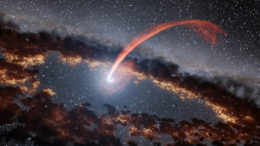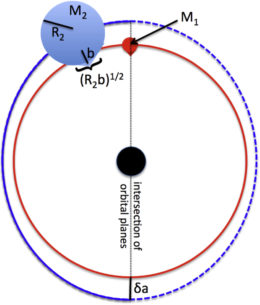When a normally dormant supermassive black hole burps out a brief flare, it’s assumed that a star was torn apart and fell into the black hole. But a new study suggests that some of these flares might have a slightly different cause.
Not a Disruption?

Artist’s impression of a tidal disruption event, in which a star has been pulled apart and its gas feeds the supermassive black hole. [NASA/JPL-Caltech]
This discrepancy has led two scientists from the Columbia Astrophysics Laboratory, Brian Metzger and Nicholas Stone, to wonder if we can explain flares from supermassive black holes in another way. Could a different event masquerade as a tidal disruption?

Evolution of a star’s semimajor axis (top panel) and radius (bottom panel) as a function of time since Roche-lobe overflow began onto a million-solar-mass black hole. Curves show stars of different masses. [Metzger & Stone 2017]
Inspirals and Outspirals
In the dense nuclear star cluster surrounding a supermassive black hole, various interactions can send stars on new paths that take them close to the black hole. In many of these interactions, the stars will end up on plunging orbits, often resulting in tidal disruption. But sometimes stars can approach the black hole on tightly bound orbits with lower eccentricities.
A main-sequence star on such a path, in what is known as an “extreme mass ratio inspiral (EMRI)”, slowly approaches the black hole over a period of millions of years, eventually overflowing its Roche lobe and losing mass. The radius of the star inflates, driving more mass loss and halting the star’s inward progress. The star then reverses course and migrates outward again as a brown dwarf.
Metzger and Stone demonstrate that the timescale for this process is shorter than the time delay expected between successive EMRIs. The likelihood is high, they show, that two consecutive EMRIs would collide while one is inspiraling and the other is outspiraling.
Results of a Collision

Schematic diagram (not to scale) showing how two circular EMRI orbits can intersect as the main-sequence star migrates inward (blue) and the brown dwarf very slowly migrates outward (red). [Metzger & Stone 2017]
If the stars instead meet on a grazing collision, Metzger and Stone show that this liberates gas from at least one of the stars. The gas forms an accretion disk around the black hole, causing a transient flare similar to some of the harder-to-explain flares we’ve observed that don’t quite fit our models for tidal disruption events.
In this latter scenario, the stars survive to encounter each other again, decades to millennia later. These grazing collisions between the pair can continue to produce quasi-periodic flares for thousands of years or longer.
Metzger and Stone argue that EMRI collisions have the potential to explain some of the flares from supermassive black holes that we had previously attributed to tidal disruption events. More detailed modeling will allow us to explore this idea further in the future.
Citation
Brian D. Metzger and Nicholas C. Stone 2017 ApJ 844 75. doi:10.3847/1538-4357/aa7a16

1 Comment
Pingback: 2017 HEAD: Day 3